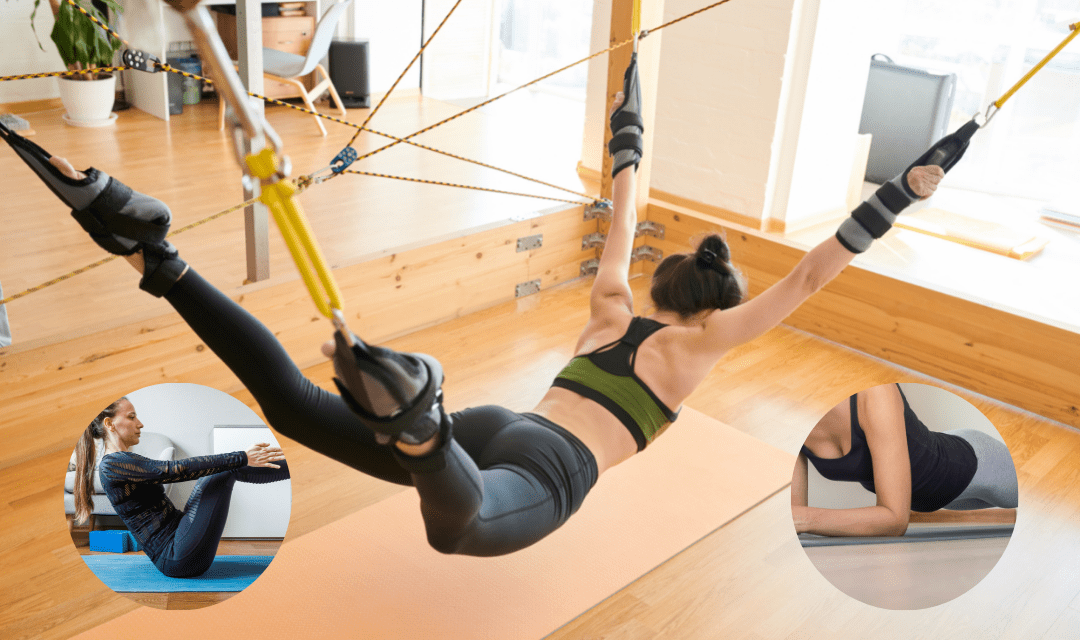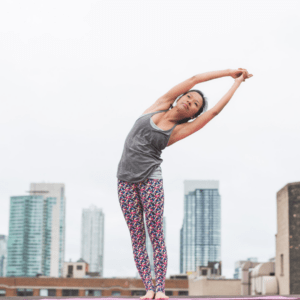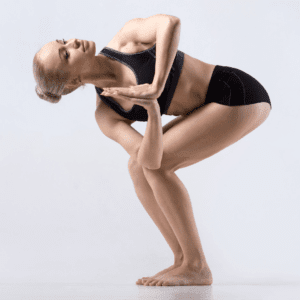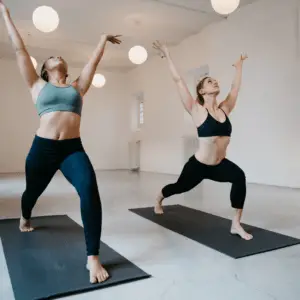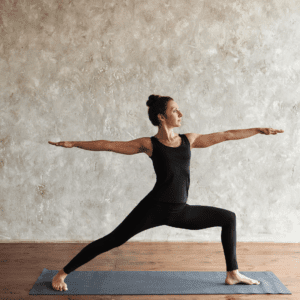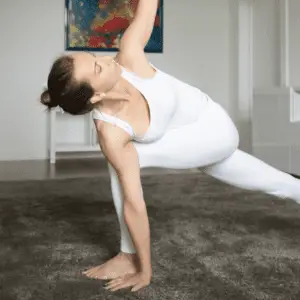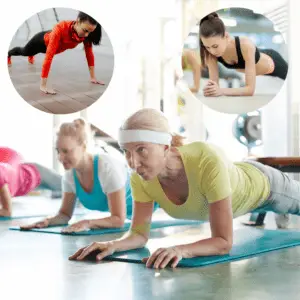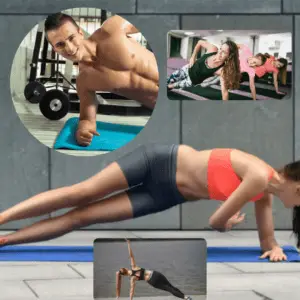Our core muscles are considered the central power and balance in our body. Therefore, they help, enhance, and stabilize our related physical workouts and difficult strength and flexibility exercises. In this premise, yoga practice needs core stability to execute properly and effectively yoga poses, especially the most extensive and difficult ones. Hence, we have yoga for core strengthening.
Strengthening our core muscles and discovering their power must be one of the ultimate purposes in engaging into certain fitness journey, yoga for example or other flexibility, conditioning, and power exercises.
Augmenting core energy benefits other strenuous body movements during the course of physical fitness activity. When core power is at its heights, balance is next to perfect, if not absolutely flawless. Your strength will be supplemented by the power assistance that core muscles will give it.
Indispensably, if we are going to indulge ourselves into a determined and focused fitness voyage, we should not forget to strengthen our core, simultaneous or in close connection with our related workout patterns, be it yoga for core and strength improvement, other exercise activities, or isometric exercise [1]Isometric exercise, Wikipedia and conditioning routines.
How does core strength significantly boost exercise?
When you have a powerful core, your exercise movements have that support of absolute and strong stability, as a necessary consequence. Moreover, balance and coordination will be enhanced. Typically, difficulty in workout execution shows lack of core strength.
Thus, you should fortify your core muscles to have the superb extra power lift.
Core workouts | Strong Core and Stable Balance
Core muscles are vital if one, who is indulging in an intense physical exercise, wants to achieve stability and balance. Your movement coordination will have the added strength and lift to have that desired strength execution, be it weightlifting, high intense strength and conditioning physical activities, flexes and yoga poses, or other taxing exercises.
“Core exercises train the muscles in your pelvis, lower back, hips and abdomen to work in harmony. This leads to better balance and stability, whether on the playing field or in daily activities. In fact, most sports and other physical activities depend on stable core muscles.” [2]Core Exercises: Why should you strengthen your core muscles, Mayoclinic
Core Exercises | Practicality and Consequential Boon
Aside from this, it is but apparent and manifest that core strengthening workouts do not require expensive exercise equipment, with greater extent, highly priced gym membership.
Much more than stability and balance, these core exercises can tone your abs; thus, by engaging consistently with such workouts, you will be having that desired flat belly appearance, not later but, we believe, sooner.
Having a fortified core muscles will make it seamless for one to do most physical activities and exhaustive fitness routines. Perforce, focused, determined, and targeted core workouts will assist you to achieve your lifestyle fitness goals and objectives.
Yoga Poses and Postures to Benefit and Fortify your Core | Chosen and Selected
There are known yoga poses that can help you in your core exercises. Doing these will fortify and strengthen that vital region of your body. Here are the chosen and selected poses you can study, perform, and pattern your exercise, or make a warm-up of the same before engaging into your main workout.
Reed Pose

We start with standing pose. This posture is also known as the Reed Pose. Coupled with other yoga exercises, this movement will also help you develop your core strength.
This is one of the fundamental and basic postures, for beginners, intermediate, and advanced alike. This puts emphasis on your core area.
- First, begin with standing position. Distance wise, both your feet must at hip’s length, while your toes point in a forward direction.
- Then, flex both your arms high up in the air. While in that pose, slowly direct your both hands to each other, and afterwards, interconnect both your left and right fingers, without clasping your hands.
- Nonetheless, you can alternate it with clasping your hands still, if you feel comfortable.
- As you breathe in, try to rise and reach further what is above you without limit, as far up as you can go, but without raising your ankles. You will feel the stretch. At this point, while breathing out, you gradually lean to your right side first.
- At this juncture, you will feel the muscle strain in your left side, hence, you will experience the flex therein. In this position, nevertheless, you are also crunching your right side.
- Thereafter, breathe in again, the slowly bring yourself to your original position.
- Repeat the same process, but now on your left side, thereby, stretching your right at this point. Hold your position as you flex and feel the muscle strain.
Twisting Chair Pose
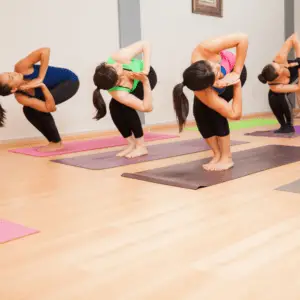
One option for improving your side and front abdominal muscles to develop abdominal strength is this Chair Pose Yoga with a Twist. Likewise, this is a balancing exercise. Yoga practitioners at all levels, be they beginners, intermediate, or advanced, must have this in their repertoire of poses.
This posture helps to stabilize the core region as it carries strength and solidity in the said area.
- Again, initially begin with erected position.
- Breathe in then make your arms as if trying to reach the ceiling.
- Then, let your breath out or respire while simultaneously and slowly positioning yourself to sit on an imaginary chair behind you.
- Next, put your arms and hands in a like prayer posture in front of your chest, flatly sticking them face palm, just like you are in a prayer mode.
- Be still, and at this moment, you should be keeping your fortified stance. You will be slowly feeling muscle strain in your legs. Yet, do not worry.
- Your feet must be flat and secure on the floor with your hips above closely inclined with, or slightly positioned higher than, your knees.
- Let the air flow in, when you inhale at this position, to create enough strength and length on your spine.
- Breathe out to twist in circular motion your body, first, towards your inner right side.
- You, once more, will experience muscle strain on your core and consistently on your legs. Even if you will not twist too far, still, your core can reap the benefits of this position.
- Try to maintain your position for at least five (5) to ten (10) breaths.
- Execute the same pattern on the other side.
Warrior I Pose | The Victory
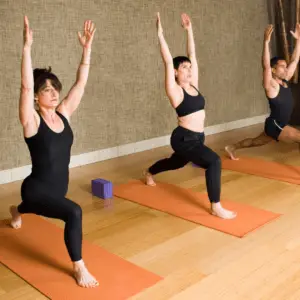
A standing yoga posture, executing Warrior 1 Pose will build concentration, energy and balance. The same flexes the anterior side of the body and suitable for developing strong points on the core, back, and legs.
Warrior I is a modification of the side angle pose in yoga, a usual yoga posture that has-off-shoot variations. From Warrior I, therefore, you can shift to Warrior II pose just by leveling your arms, with your shoulder, one forward, the other backward or vice versa, from Warrior II to Warrior I.
Warrior II Pose
- Starting with Warrior I, same as the previous, begin with standing position.
- Next, go to lunge position by stepping forward using your right foot first, bending your knees in the process, with both of your arms at the side still.
- Then, in that lunge position, slowly raise both your arms as high as you can, with your both feet firmly secured to the ground. While raising your arms, breathe strategically.
- Create a slightly V-shape figure with your arms over your head, with your spine slightly bent forward.
- Your left torso is open at this stage. Hold it open. It is like an upright twist since your left foot is positioned backward, and your right foot is lunged forward, thereby, creating a tension in your core area.
- At this point of holding still, you are engaging your core.
- Inhale and exhale deeply. Concentrate while breathing out as this will further engage your core muscles, creating abdominal contractions.
- Be in this position for half (1/2) a minute before returning to standing and original position.
Revolving Angle Pose | The Revolved Side Angle Pose
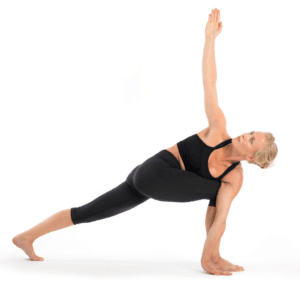
Revolving Angle Pose or Revolved Side Angle Pose is a tension-packed workout for the muscles that the same targets. In short, it is a high intense twisting yoga core workout.
Your body’s stability, knack for balance, power, energy, flexibility, and mental sagacity are being put to test; it is akin to placing it on trial.
This yoga posture, experts consider, has a purging and cleansing power. In executing the pose, it necessarily squeezes the vital organs in the abdomen.
By doing so, it violently expels the toxins out, and the harmful wastes, from the body. After releasing the curb and twisted position, renewed blood immediately flows back to the organs, engulfing the cells with nutrients.
- Depending on your preference, from Warrior I, you can do the Revolved Side Angle Pose.
- Next, when you are on your right side from the initial Warrior I position, gradually place your left hand to the floor to touch, by your outer left palm, the right side of your foot.
- Raise, likewise, slowly your right hand as if you want to touch the ceiling.
- Then, elevate your left ankle, by lifting your foot’s flat surface through your tip toe.
- You will now feel that your core is engaged. It is working at the same time to stabilize your balance.
- In this position, you are targeting your obliques.
- Strategize your breathing by inhaling and exhaling calmly yet deep. While you are breathing, your core is further engaged, helping your abdominal muscles to develop its strength.
- Keep this pose for at least five (5) to fifteen (15) strategic breathing.
Boat Pose | The V-Shape Posture
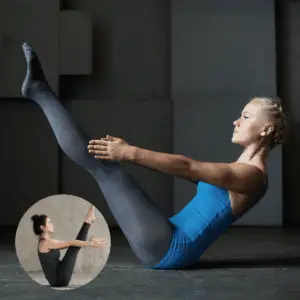
The Boat Pose is one of the basic and standard yoga poses that can develop and nurture your core strength. A fixed and engaging yoga pose, the Boat Pose helps your firmness, solidity, mobility, and stability to progress; such posture will eventually improve them.
- Begin this posture by sitting on the floor. Your legs must be flat out first on the floor, and stretched to align them parallel with the ground surface.
- Be aware of your spine. Initially, it must be extended in an upright position.
- Next, slowly lean backwards. This time, while bending back to the floor, you, likewise, gradually bend your knees.
- Then, in that position, while still slowly leaning, try to lift up both your feet forming an imaginary 45-degree triangle.
- Stretch both your fee to make your legs fully engaged.
- When you feel that you already attain a V-shape angular pose, keep holding on to it.
- Simultaneously breath calmly and strategically keeping your core activated.
- Breathing is important at this stage, as in any other core-engaging yoga executions.
- As a beginner, you will initially extend your arm, when you are in V-shape position, slightly above the level of your shoulder.
- As you progress, you will eventually rise your hand parallel to your legs.
- At this position, you can also execute a core-activating abdominal lock. This is done by strategic breathing while stationary on the boat pose.
- Keep and hold on to the V-shape Boat Pose posture for at least ten (10) to twenty (20 breaths.
Bridge Pose | Backbend Position for Core Strength
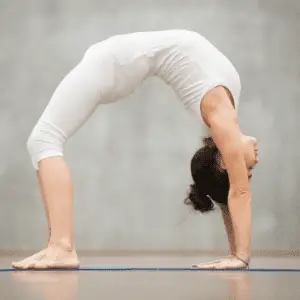
Bridge pose, besides being a core strengthening pose, is undoubtedly, also a back exercise. You may also want firm up your back muscles and stretch your bones and joints [in order to have a better alignment] complementarily to revving up your abdominal routine exercises to increase its core power.
- Begin by lying down, your back against the floor.
- Your knees should be bent, and your both feet have to flat on the surface floor.
- Straighten up your shin and vertically align your knee with your ankle and heels for better balance.
- Exhale, then secure your feet by pressing them firmly onto the ground. This will help you, when lifting your hips from the floor.
- Arms curve/bend at ninety (90) degrees to push the back of your arms.
- Pressing firmly your arms onto the floor will make you rise up your torso.
- In this backbend pose, you will open the front side of your body in a curve manner slightly raising the middle part of it.
- Keep this pose and at the same time breath strategically, inhaling and exhaling the air to and from your body.
- Maintain, as well, this position for at least ten (10) to twenty (20) inhales and exhales.
You should know that constant execution of this posture will fortify and solidify your back muscles. This will target specifically the myo erectus [erector muscles]. We all know that these support the spine; hence, this exercise is very helpful to it.
Bridge Pose focuses and concentrates on the lower back region.
Wheel Pose | The Heightened Bridge Pose

Wheel pose is a next level bridge pose. Thus, after concluding your bridge posture exercise, you may want to proceed to wheel pose execution.
Just as is with the bridge pose, the wheel posture will benefit your back, yet, in its entirety. It will laser-focus on your hard to reach back muscles. Much more, it will engage a substantial part of your core region.
- To begin, lie down on the ground, as with the bridge pose.
- Bend your knees at the same time.
- Both feet securely pressed onto the ground.
- Your arms, while lying down, should be bent and extended away from your shoulder.
- Hands, as well, must be trivially wider than the shoulder for better leverage ad alignment
- Your elbow must be pointing upwards.
- Place your hands face palm firm on the floor; your fingers pointing to your head.
- Start by lifting the middle part of your body while your feet and hands firmly pressing the ground.
- Calmly breath and engage your core while inhaling.
- Exhale, then, raise your body as high as you can; higher than the bridge pose.
- Then lift your heels and ankle; put the strength now on your toes.
- While in this position, always calmly and deeply breathe.
- By inhaling and exhaling and being aware of your core muscles, you are continuously engaging them.
- Maintain this position for at least fifteen (15) to thirty (30) seconds.
Plank Pose | The Dolphin Plank
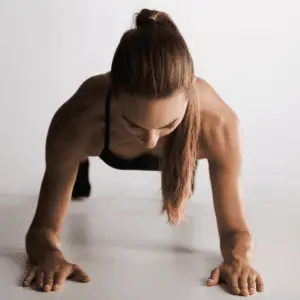
Plank Pose or Dolphin Plank is undeniably a core exercise. It is easy to position yourself. However, as you maintain it, that is the time that it gets harder. It is a stationary position, which you will keep for a certain period of time.
- Lie down prostate to the ground.
- Place your hand on your side.
- Now, face palm your hand onto the floor at the side of your chest.
- Raise your body through the strength of your arms.
- Fully extend your arms and fix your body on top.
- Your legs must be inclinedly aligned with your body as you rise up.
- Be sure that your hands are also aligned with your shoulders.
- Now, gently lower both your elbow for it to touch the floor
- Alternately do this. Make sure your elbows, this time, are the ones aligned with your shoulder.
- Both your arms and forearms should parallel with each other on their respective positions.
- You may want to join the tips of your forefingers, index fingers, and middle fingers to for a triangle forearm support, or even interlacing your fingers, thus, clasping them.
- Engaged your core by breathing strategically, calmly, and deeply.
- Keep yourself on this position for at least thirty seconds, for a beginner. More than for intermediate and advanced.
Side Plank Twist | Harnessing the Obliques

Obliques are pat of the core system. It must be developed as well. They are hard to reach muscles.
Wanting to harness your obliques? You are in the right place. You can improve, develop, and nurture your obliques by doing, among others, the Side Plank Twist. It is a ramification of plank poses.
Indulging consistently in such posture, you will be able to progress you core balance and stability. Moreover, when you rotate while in side twist position, you will be further engaging your core muscle fibers.
- While in the straight plank position [not bended elbows], breathe in and gradually lift up your right hand straight up to the air in a straight line.
- From there, breathe out and slowly rotate your right-hand inwards to and underneath your body.
- Your left arm and forearm must be in a bow-like position under your torso.
- Rotate as far as you can go. Hold your position from there for one (1) to two (2) seconds.
- Then, slowly pull your right arm underneath your body and raise your hand again to the air achieving the straight alignment of both your left and right arms.
- Repeat the process and the circular rotation underneath your body five (5) to ten (10) times, depending on your capability.
- Breathe and engage your core.
- Do the same process and motion on the opposite side and repeat the movements in similar repetitions.
Final Thoughts
As the saying goes, “health is wealth”. At this point, when so much is at risk in terms of global health, we should still be positive. We must enjoy our lives. By having that in mind, health goals will stand out. Thus, we should strive hard for our mind and body to attain their optimum fitness.
Exercise, proper food, rest and relaxation, and most importantly peace of mind, all these will direct our path to a more healthier life style.
In exercise for that matter, we must have balance and stability to execute and perform properly any kind of fitness workouts, especially those intense ones and the flexibility, conditioning, and strength exercises.
In all of these, the common denominator is that you must have core power and energy. Core muscles are the primary source of core strength. Hence, we should develop and optimize them for our fitness purposes.
The above-tackled poses, among others, may kickstart your core power objectives. As you go along perfecting them, you will constantly advance to a more difficult and extensive core engaging techniques, such as isometrics.
Consequently, incorporating core strengthening activities is beneficial to your over-all health and fitness lifestyle objectives.
This is most true to those people who are determined to embark into next level workout program.
References
| ↑1 | Isometric exercise, Wikipedia |
|---|---|
| ↑2 | Core Exercises: Why should you strengthen your core muscles, Mayoclinic |

